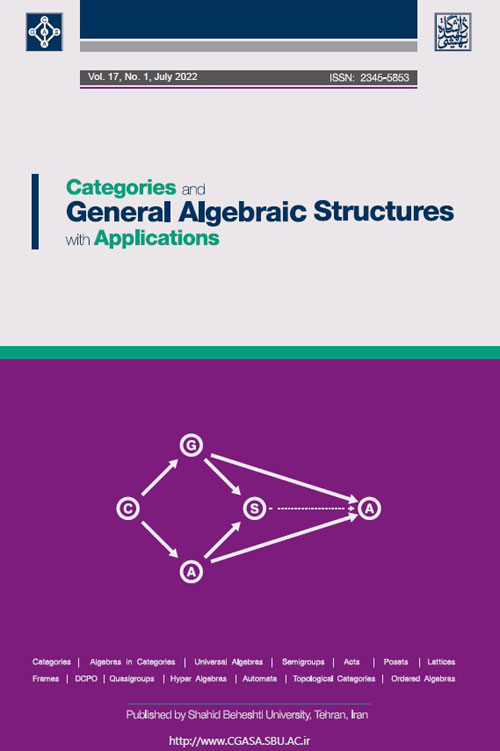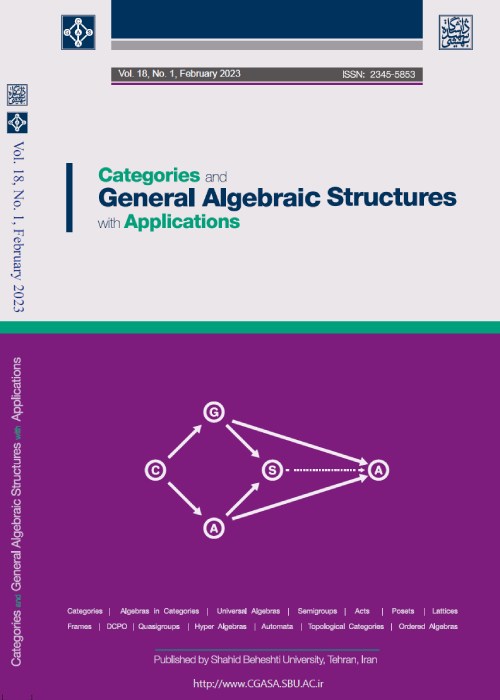فهرست مطالب

Categories and General Algebraic Structures with Applications
Volume:17 Issue: 1, Jul 2022
- تاریخ انتشار: 1401/05/31
- تعداد عناوین: 8
-
-
صفحات 47-83
-
صفحات 101-116
-
صفحات 117-139
-
صفحات 141-172
-
صفحات 203-232
-
Pages 1-45
We build on previous work on multirings ([17]) that providesgeneralizations of the available abstract quadratic forms theories (specialgroups and real semigroups) to the context of multirings ([10], [14]). Herewe raise one step in this generalization, introducing the concept of pre-specialhyperfields and expand a fundamental tool in quadratic forms theory to themore general multivalued setting: the K-theory. We introduce and developthe K-theory of hyperbolic hyperfields that generalize simultaneously Milnor’sK-theory ([11]) and Special Groups K-theory, developed by Dickmann-Miraglia ([5]). We develop some properties of this generalized K-theory, thatcan be seen as a free inductive graded ring, a concept introduced in [2] inorder to provide a solution of Marshall’s Signature Conjecture.
Keywords: quadratic forms, special groups, K-theory, multirings, hyperfields -
Pages 47-83
Bilattices, which provide an algebraic tool for simultaneously modelling knowledge and truth, were introduced by N.D. Belnap in a 1977 paper entitled How a computer should think. Prioritised default bilattices include not only Belnap’s four values, for ‘true’ (t), ‘false’(f), ‘contradiction’(⊤) and ‘no information’ (⊥), but also indexed families of default values for simultaneously modelling degrees of knowledge and truth. Prioritised default bilattices have applications in a number of areas including artificial intelligence. In our companion paper, we introduced a new family of prioritised default bilattices, Jn, for n ⩾ 0, with J0 being Belnap’s seminal example. We gave a duality for the variety Vn generated by Jn, with the dual category Xn consisting of multi-sorted topological structures. Here we study the dual category in depth. We axiomatise the category Xn and show that it is isomorphic to a category Yn of single-sorted topological structures. The objects of Yn are ranked Priestley spaces endowed with a continuous retraction. We show how to construct the Priestley dual of the underlying bounded distributive lattice of an algebra in Vn via its dual in Yn; as an application we show that the size of the free algebra FVn(1) is given by a polynomial in n of degree 6.
Keywords: Bilattice, default bilattice, natural duality, multi-sorted natural duality, Priestley duality, piggyback duality -
Pages 85-100
In this article we consider some relations between the topological properties of the spaces X and Min(Cc (X)) with algebraic properties of Cc (X). We observe that the compactness of Min(Cc (X)) is equivalent to the von-Neumann regularity of qc (X), the classical ring of quotients of Cc (X). Furthermore, we show that if 𝑋 is a strongly zero-dimensional space, then each contraction of a minimal prime ideal of 𝐶(𝑋) is a minimal prime ideal of Cc(X) and in this case 𝑀𝑖𝑛(𝐶(𝑋)) and Min(Cc (X)) are homeomorphic spaces. We also observe that if 𝑋 is an Fc-space, then Min(Cc (X)) is compact if and only if 𝑋 is countably basically disconnected if and only if Min(Cc(X)) is homeomorphic with β0X. Finally, by introducing zoc-ideals, countably cozero complemented spaces, we obtain some conditions on X for which Min(Cc (X)) becomes compact, basically disconnected and extremally disconnected.
Keywords: The space of minimal prime ideals, strongly zero-dimensional space, countably basically disconnected space, countably cozero complemented space, $z^0, c$-ideals -
Pages 101-116
A specialization semilattice is a join semilattice together with a coarser preorder ⊑ satisfying an appropriate compatibility condition. If X is a topological space, then (P(X),∪,⊑) is a specialization semilattice, where x ⊑ y if x ⊆ Ky, for x, y ⊆ X, and K is closure. Specialization semilattices and posets appear as auxiliary structures in many disparate scientific fields, even unrelated to topology. In a former work we showed that every specialization semilattice can be embedded into the specialization semilattice associated to a topological space as above. Here we describe the universal embedding of a specialization semilattice into an additive closure semilattice.
Keywords: Specialization semilattice, closure semilattice, closure space, universal extension -
Pages 117-139
In the theory of crossed modules, considering arbitrary selfactions instead of conjugation allows for the extension of the concept of crossed modules and thus the notion of generalized crossed module emerges. In this paper we give a precise definition for generalized cat1-groups and obtain a functor from the category of generalized cat1-groups to generalized crossed modules. Further, we introduce the notions of coverings and liftings for generalized crossed modules and investigate properties of these structures. Main objective of this study is to obtain an equivalence between the category of coverings and the category of liftings of a given generalized crossed module (A,B, α).
Keywords: generalized crossed module, generalized cat1-groups, Covering, lifting -
Pages 141-172
Each nominal set 𝑋 can be equipped with a preorder relation ⪯ defined by the notion of support, so-called support-preorder. This preorder also leads us to the support topology on each nominal set. We study support-preordered nominal sets and some of their categorical properties in this paper. We also examine the topological properties of support topology, in particular separation axioms.
Keywords: nominal set, support-preordered nominal set, support topological nominal set -
Pages 173-201
In this paper, motivated by Cagliari and Mantovani, we have obtained a characterization of injective objects (with respect to the class of embeddings in the category 𝑄-TOP of 𝑄-topological spaces) in the comma category 𝑄-TOP/(𝑌,𝜎), when (𝑌,𝜎) is a stratified 𝑄-topological space, with the help of their 𝑇0-reflection. Further, we have proved that for any 𝑄-topological space (𝑌,𝜎), the existence of an injective hull of ((𝑋, 𝜏), 𝑓 ) in the comma category 𝑄-TOP/(𝑌, 𝜎) is equivalent to the existence of an injective hull of its 𝑇0-reflection ((𝑋 ̃,𝜏 ̃), 𝑓 ̃) in the comma category Q-TOP/(𝑌 ̃, 𝜎 ̃ ) (and in the comma category 𝑄-TOP0/(𝑌 ̃, 𝜎 ̃ ), where 𝑄-TOP0 denotes the category of 𝑇0-𝑄-topological spaces).
Keywords: Injective objects, Injective hull, T0-reflection -
Pages 203-232
The aim of this paper is to introduce an abstract notion of determinant which we call quantum determinant, verifying the properties of the classical one. We introduce R−basis and R−solution on rigid objects of a monoidal 𝐴𝑏−category, for a compatibility relation R, such that we require the notion of duality introduced by Joyal and Street, the notion given by Yetter and Freyd and the classical one, then we show that R−solutions over a semisimple ribbon 𝐴𝑏−category form as well a semisimple ribbon 𝐴𝑏−category. This allows us to define a concept of so-called quantum determinant in ribbon category. Moreover, we establish relations between these and the classical determinants. Some properties of the quantum determinants are exhibited.
Keywords: Monoidal category, Ribbon category, duality, quantum determinant, quantum trace


